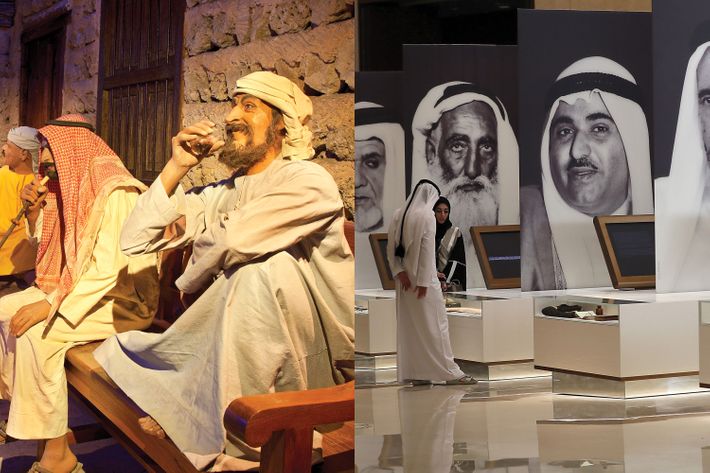
In a city where breaking world records is practically a national pastime, it’s easy for visitors to end up chasing the superlatives — the tallest this, the biggest that, the fastest whatever … you get the picture. And with more than 15 million people visiting Dubai in 2017 alone, that’s a whole lot of tourists swarming the same exact places. Without further ado, here are five worthy alternatives to some of the city’s biggest tourist draws.

Instead of the Burj Khalifa, go to … the Dubai Frame
We get it. You want to tick going up the world’s tallest building off your bucket list. But novelty aside, the panoramic view from the 2,716-foot-high observation deck is missing one vital component from the city’s skyline: the building you’re standing in. For a better view — one that encompasses Dubai’s development from old to new — check out the Dubai Frame. This relatively new landmark in Zabeel Park is shaped like a gigantic gold-plated picture frame and located roughly a 10-minute drive from Burj Khalifa. At its base, there’s a museum that celebrates Dubai’s past, but really it’s the view from the 48th floor that you’ve come for. Let the elevator whisk you up to take in the gleaming skyscrapers of downtown to the south, and the white expanse of low-rises that is Deira and Dubai Creek to the north. Entry to the Frame is good value at $14 per adult, compared to $37 to go up Burj Khalifa.

Instead of Dubai Museum, go to … Etihad Museum
Granted, Dubai Museum looks pretty cool from the outside. It’s located within the restored Al Fahidi Fort, which was originally built in the 1700s, and inside you’ll find a handful of items which help document Dubai’s rise from humble fishing village to global hub. But note we used the word handful. This museum is small, and a little worn around the edges, too. For a high-tech alternative, head to the Etihad Museum next to Union House, where the treaty that established the UAE was signed in 1971. The museum covers 6.2 acres and takes the shape of a manuscript, with seven columns representing the pens used to sign the original declaration. Designed by Moriyama & Teshima Architects, it’s a stunning feat of architecture, but the true magic happens as you head down the steps to the museum itself, home to some of the most important relics in the country’s relatively short history. Perhaps its star attraction is an original copy of the UAE Constitution: A projected waterfall of independence-related text in both Arabic and English frames the glass case, and a well-placed skylight envelops it in an eerie light.

Instead of JBR public beach, go to … La Mer
It’s not that we don’t like JBR’s public beach, we do. But so does everyone else. The main stretch of coastline — aptly known as “the Beach” — located just behind Dubai Marina has become one of the busiest spots in the city. Besides the public beach itself, there’s a multiplex cinema, several high-street shops, an outdoor gym, and plenty of unlicensed (i.e., soft drinks only) restaurants. At peak times, the traffic is totally gridlocked. For a more relaxing experience, take your towel to La Mer, a colorful new development that’s similar to JBR but far less crowded. There’s an inflatable playground for kids, water hammocks suspended on stilts over the water, and licensed restaurants (i.e., with alcohol!) lining the sand.

Instead of Jumeirah Mosque, go to … Sheikh Mohammed Centre for Cultural Understanding
As the only mosque in Dubai that is open to the [non-Islamic] public, Jumeirah is understandably high on many visitors’ sightseeing checklists. But joining one of the 75-minute guided tours can feel a bit like being herded through; and besides the mosque itself, there’s not much to see in the surrounding area. An equally inspiring alternative is the Sheikh Mohammed Centre for Cultural Understanding (SMCCU), a nonprofit that hosts gatherings in the courtyard of a wind tower in Al Fahidi Historical Neighborhood, where guests are welcome to share a meal with Emirati hosts and learn about the culture, customs, and religion of the UAE in an informal environment. SMCCU also tacks on heritage tours around the neighborhood, including a special visit to the nearby Diwan mosque, which is only accessible to SMCCU’s guests.

Instead of a generic desert safari, go with … Platinum Heritage
A desert safari is a rite of passage for most visitors to Dubai. Typical tours pick you up in a white Land Cruiser from your hotel and drive you out to the dunes for a bit of roller coaster off-roading, before stopping at a Bedouin-inspired campsite for an enormous buffet-style dinner and belly-dancing show. But Platinum Heritage’s vintage vehicles make the desert safari experience extra special. Even if you’re not into cars, you’ll still appreciate the cool factor that comes with sailing over the sand in a classic 1950s Land Rover. Even its Bedouin camp, located in the Dubai Desert Conservation Reserve, is more realistic, with authentic Arabic food and a rustic but elegant campsite lit up by lanterns, not flood lights. Overnight stays are also available.